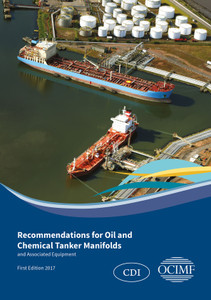
This publication provides best practice guidance for safe and pollution-free operations on board chemical tankers and oil tankers carrying chemical cargoes in accordance with MARPOL Annex II.
This guide contains best practice guidance for safe and pollution-free operations on ships regulated under MARPOL Annex II (Regulations for the Prevention of Pollution by Noxious Liquid Substances). This includes oil tankers operating in accordance with Annex II when carrying chemical cargoes.
Now in its fifth edition, it contains new guidance on key safety issues and operations, including space entry, risk assessments and PPE, as well as new and improved ship/shore safety checklists. It is aligned with ISGOTT: International Safety Guide for Oil Tankers and Terminals, Sixth Edition.
The first edition of the ICS Tanker Safety Guide (Chemicals) was published in 1971. Revisions to subsequent editions of the Guide have established it as the standard reference work for chemical tankers, taking particular account of the need for chemical tankers to comply with IMO regulations.
This fifth edition continues to provide those serving on ships carrying hazardous and noxious chemicals in bulk with up-to-date information on recognised best practice for safe and pollution-free operations on ships regulated under MARPOL Annex II (Regulations for the Prevention of Pollution by Noxious Liquid Substances). This includes oil tankers operating in accordance with Annex II when they are carrying chemical cargoes. However, its contents are also relevant to shipping companies, cargo interests, training institutes and terminal operators.
In response to feedback from users, the fifth edition is the result of further revision and updating. In order to improve access to important information, some content from the previous edition’s appendices has been incorporated into the main body of the text, which has been redrafted in the interests of improved understanding.
This edition also includes comprehensively revised checklists. Checklist questions have been redrafted and share features with those used by other comparable industries to reflect current human factors understanding. When a positive response to a question is not possible the remarks column is used to provide further explanation. For an operation to proceed all responses should either be positive, or justification in the ‘remarks’ column be sufficient to allow the operation to go ahead.
This edition has removed the separate extensive guidance that used to be part of the checklists. Instead, checklist items now include references to sections in the main body of text that provide relevant guidance for those particular items.
Reflecting that serious enclosed space accidents unfortunately continue to occur, primarily due to a failure to follow established procedures, the previous edition provided updated and improved guidance on this most important safety topic. This text has been retained with little change in this fifth edition that continues to have separate chapters dedicated to enclosed space entry precautions and to the correct use of nitrogen as an inerting medium.
The Guide uses yellow coloured text boxes to summarise and highlight key safety issues. Although readers should pay particular attention to the guidance in the yellow boxes, it should be understood that these only serve to amplify the main text. A full and careful reading of all guidance on the subject is essential in order to achieve a comprehensive understanding.
The Guide deals primarily with operational matters and best safety practices. It does not make recommendations on the construction or maintenance of chemical carriers or their equipment: such standards are set by IMO, national administrations and classification societies. Likewise, the Guide does not address the operation of specific items of equipment or their repair. However, in some cases general reference is made to these matters as well as to relevant regulations.
It is recommended that a copy of this Guide be used on board all chemical tankers, which should also have on board the International Safety Guide for Oil Tankers and Terminals (ISGOTT) with which this Guide is compatible and which should also be consulted, especially whenever oil cargoes are carried. This compatibility will provide consistent safe guidance and minimise the increasing burden associated with audits and vetting inspections. This Guide is also a companion to the ICS Tanker Safety Guide (Liquefied Gas).
It should be noted that this Guide is not intended to address commercial matters such as tank cleaning standards, cargo quality maintenance or equipment performance, which (consistent with IMO regulations) may be determined by industrial practices and the requirements of cargo owners.
Chapter 1: Hazards and Properties of Chemicals
Chapter 2: General Precautions
Chapter 3: Safety Management, Training and PPE
Chapter 4: Regulatory Framework
Chapter 5: Ship and Equipment
Chapter 6: Cargo Operations
Chapter 7: Inert Gas and Nitrogen Safety
Chapter 8: Tank Cleaning and Gas Freeing
Chapter 9: Entry into Enclosed Spaces
Chapter 10: Emergency Procedures
Appendices:
Appendix
A
–
Visitor
Information
Card
Appendix
B
–
Ship/Shore
Safety
Checklist
Appendix
C
–
Safety
Data
Sheet
(SDS)
Appendix
D
–
Certificate
of
Protection
Appendix
E
–
Enclosed
Space
Entry
Permit
Appendix
F
–
PPE
Matrix
Appendix
G
–
Relevant
Industry
Publications
ICS
The International Chamber of Shipping (ICS) is the principal international trade association for the shipping industry, representing shipowners and operators in all sectors and trades. ICS membership comprises national shipowners' associations in Asia, Europe and the Americas whose member shipping companies operate over 80% of the world's merchant tonnage.
Established in 1921, ICS is concerned with all technical, legal, employment affairs and policy issues that may affect international shipping.
ICS represents shipowners with the various intergovernmental regulatory bodies that impact on shipping, including the International Maritime Organization.
ICS also develops best practices and guidance, including a wide range of publications and free resources that are used by ship operators globally.
- Number of Pages:
- 298
- ISBN:
- 9781913997007
- Book Height:
- 210 mm
- Book Width:
- 150 mm
- Author:
International Chamber of Shipping
- Published Date:
- January 2021
- Preview:
- Yes





